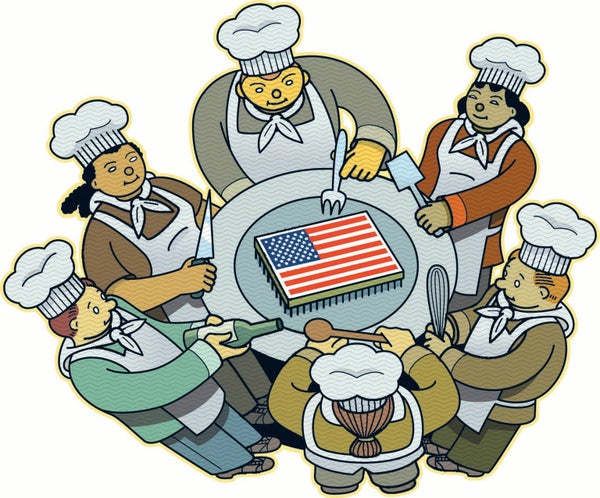Making the next generation of computer chips demands the care of preparing a gourmet meal at an industrial scale. The finest ingredients, techniques and tools and, of course, the sharpest minds must come together to create something transformative. In kitchens, when just one of these elements is missing, the meal falls short.
The U.S. Department of Commerce will soon command a feast of sorts, doling out $11 billion for research and development under the CHIPS and Science Act to revive America's sluggish chipmaking industry. Currently the U.S. produces only 12 percent of chips worldwide. In passing CHIPS, the federal government asserted a bold desire to return to the forefront of chipmaking. Between desire and doing, however, lies a profound gap. It will not be easily spanned.
The CHIPS Act promises a lot of funding, but numbers hardly guarantee success. Chipmaking is an almost incomprehensibly precise, difficult and expensive business. Ensuring that the U.S. is among the world's leading makers will take innovation and collaboration of epic proportions.
On supporting science journalism
If you're enjoying this article, consider supporting our award-winning journalism by subscribing. By purchasing a subscription you are helping to ensure the future of impactful stories about the discoveries and ideas shaping our world today.
Lowering the barriers to participation and financing is critical to the success of America's CHIPS-inspired semiconductor future. The nearly $600-billion global semiconductor-chip industry makes more than a trillion chips every year, which go into everything from cars to coffeemakers. A “more is merrier” approach would create a vibrant and fast-moving network of innovation to produce the breakthroughs needed for technology to flourish.
So far a lot of attention has instead been directed at the biggest, and often slowest-moving, players in the industry. The U.S. thrives on invention, yet many of the most creative minds at smaller companies and universities have been shut out by the field's notoriously high R&D costs, as well as by lack of access to the expensive tools and facilities (often called “fabs”) needed for prototyping. As any high-end chef will tell you, you can't make something transformative if you don't have a kitchen in which to cook.
There are two ways the U.S. can allot these R&D funds. It can fall back on the “celebrity chef” approach, placing a few big bets on a handful of names and hoping for a magical breakthrough—a risky proposition. Or it can build more kitchens and invite more chefs to start cooking, placing many smaller bets on the most innovative minds to create a collaborative restaurant row of chipmaking progress where the steak, and not the sizzle, is the focus.
First, we'll need more kitchens. We must build shared experimental facilities where researchers from industry and academia work together. This environment would cultivate research communities of practice that unite top engineers in a common purpose and open doors to innovators nationwide. These technology centers can range from enhanced university fabs (semiconductor-manufacturing plants) run by experienced engineers to industry-scale facilities that showcase the product-worthiness of new ideas.
Second, we must build “digital twin” computational models that can emulate entire fabrication processes, including specifics of their tools and conditions. Digital twins will allow researchers to quickly evaluate options and accelerate the discovery of new process and device technology. By collecting large amounts of data, artificial-intelligence models could assist humans in fine-tuning delicate fabrication processes and automatically detect anomalies during manufacturing to improve production yield and quality. Such digital models will be America's ticket to leadership in semiconductor technology and in manufacturing approaches that are less dependent on humans looking at spreadsheets to make decisions.
Inherent in this vision is the key role of data sharing. The open-access facilities would be networked nationwide to enable free data distribution among the entire community, all while protecting proprietary information. The impact of the digital twins would grow exponentially as the research community expanded and as new knowledge fed innovation.
Ultimately, such a network would lower R&D costs for all players, reducing risk and bringing new ideas to market faster. A shared prototyping environment could propel the production of all kinds of chips—logic, memory, storage and specialty technologies—the way a well-equipped kitchen can turn out a variety of cuisines in a single night.
All this talk of improving access, however, overlooks one more critical factor of success: the availability of talent. Greater access means nothing if we do not have exquisitely skilled chefs eager to step into the kitchen. We must nurture a healthy industry with robust profit margins that supports career growth, attractive work conditions and suitable work-life balance to entice the next generation of engineers. Such talent does not grow on trees; it takes a decade or more for a high school graduate to earn a Ph.D. If we want to be part of a leading industry 10, 20, 30 or 100 years down the road, we must recruit and train new talent now.
The aspirations of the CHIPS Act are high. Regaining global leadership in chipmaking will not be easy, but it is within reach for a nation as capable and as motivated as the U.S. The recipe couldn't be simpler: Train the best and brightest. Create an open and collaborative ecosystem. Put cutting-edge tools in people's hands. Allow everyone to participate and share data. Then enjoy a delectable lab-to-fab meal. Bon appétit.
This is an opinion and analysis article, and the views expressed by the author or authors are not necessarily those of Scientific American.
